
SAFARI
Users
- Avocados - Mexican/Guatemalan, West Indian/Florida.
- Bay Leaves - Mediterranean, Indian, Californian, Mexican.
- Cinnamon, Cassia & Camphor
- Other Laurels - Sassafras, Ispinku, Keule, Tola
Avocado
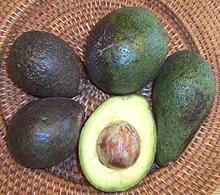 [Persea americana]
[Persea americana]
The Avocado tree is the only member of the Laurel family that's a significant food producer. Its fruit, the Avocado, is also known as Alligator Pear and Midshipman's Butter. Avocado and the Spanish aguacate are derived from the Aztec ahuacatl.
Native to the tropical Americas, this fruit is now extremely popular
worldwide and grown in many countries. Avocado oil is now also popular,
particularly for high temperature frying - it can safely go to
520°F/270°C and has a slightly buttery taste. Avocados now have
their own Avocados page.
Bay Leaves
These leaves have been very important in cooking in Europe since at least Roman times, and in North America since the European invasion. They remain kitchen essentials to this day. In northern India a slightly different leaf is used for similar purposes.
Bay Laurel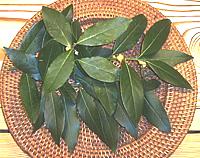 [Bay Leaf, Mediterranean Laurel, Sweet Bay, Laurus nobilis]
[Bay Leaf, Mediterranean Laurel, Sweet Bay, Laurus nobilis]
One of the most ancient and important culinary spices in Europe and the Americas, Bay Leaves are sold for high prices in little jars in the spice section of the supermarket. Look for leaves that are still reasonably green for good flavor. Fresh Bay Leaves are much more aromatic and are easy to grow in Mediterranean like climates. Here in Southern California they are very aggressive growers and I have to hack mine back continually to keep them from overrunning the place. The fresh leaves are thought to have psychoactive properties and
may have been used by oracles in ancient times but they are so bitter
when chewed nobody I know of has tried to confirm this.
Indian Bay Leaf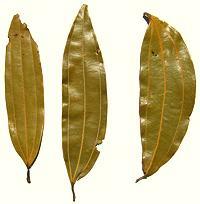 [Malabar leaf, Malabathrum; Tejpat (Nepal, Assam); Tejpatta (Hindi);
Tej Patta (Bengali), Tamalpatra (Marathi); Cinnamomum tamala]
[Malabar leaf, Malabathrum; Tejpat (Nepal, Assam); Tejpatta (Hindi);
Tej Patta (Bengali), Tamalpatra (Marathi); Cinnamomum tamala]
Well known to Roman cooks and still used for beer brewing in the Middle Ages, these leaves are now little used outside of the cuisines of northern India. Native to the Malabar (West) coast of India, they are easily recognizable for having three prominent lengthwise ribs rather than just a central rib (some other South Asian laurels also have three ribs). These leaves are considerably stronger than the familiar Bay Laurel and with a distinct overtone of Cassia (what passes for cinnamon in the US). I have found them in jars of cucumber pickles imported from India (India is a very large exporter of pickles). Judging by the color, I presume the photo specimens were gathered from such products. Caution: packages of dried leaves labeled "Indian
Bay Leaves" are usually Indonesian Bay
Leaves which are myrtles, not laurels - look for the three ribs.
Subst: regular Mediterranean bay leaves with a bit of cinnamon
added should work fine.
Photo by Sonja Pauen distributed under license Creative
Commons
Attribution 2.0 Germany.
California Laurel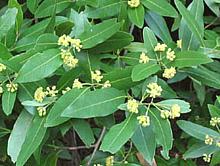 [Oregon Myrtle, California Bay, Headache Tree,
L. Umbellularia californica]
[Oregon Myrtle, California Bay, Headache Tree,
L. Umbellularia californica]
California Laurel is used similarly to the Bay Laurel for cooking but I do not recommend it. Having bit into a California Laurel fruit to see if it really did produce headaches, I had a splitting headache seemingly in seconds. Reportedly some people are sensitive to the leaves even after cooking. California Laurel is easy to tell from Bay Laurel because the leaves are more elongated, pointy and lighter in color. It is reported that American Indians in California did eat parts
of the fruit, but under very limited conditions, and only the bottom
third. The nut, similar to an avocado pit but much smaller, is
reported edible after roasting. They are roasted quite dark and
described as tasting like roasted coffee or dark chocolate depending
on how dark they are roasted. Roasted nuts are ground and used in
beverages.
Mexican Bay Leaf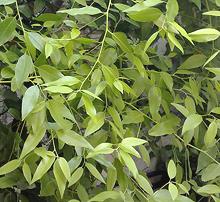 [Litsea glaucescens]
[Litsea glaucescens]
This shrub or small tree (up to 20 feet high) is native to southern
Mexico and extends down into Central America. It is used in Mexico as
a substitute for Bay Leaves in cooking. This plant is considered
threatened because it has been over-exploited for culinary, medicinal
and religious purposes (celebration of Domingo de Ramos). Local gatherers
are not harvesting in ways allowing for regeneration.
Photo by Ernestolapeña distributed under license
Creative Commons
Attribution 3.0 Unported.
|
Cinnamon, Cassia & Camphor
[genus Cinnamonum] These barks used as spices have been of great culinary importance (and high price) throughout history, and probably long before. They are from tropical trees that can't be grown in places like Europe and North America.
Cinnamon- [Cinnamonum verum (zeylanicum)]Cassia- [Cinnamomum cassia (aromaticum)]Pandang Cassia- [Indonesian Cinnamon, Korintje; Cinnamomum burmannii]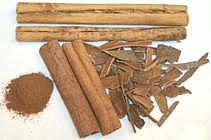
Cinnamon is native to Sri Lanka (Ceylon) and the Malabar coast of India now grown also in the West Indies and South America. Cassia is native to Burma and is grown in China, Vietnam and Indonesia with Vietnamese (Cinnamomum loureiroi) considered the highest quality. The aromatic bark of both these trees is peeled and dried for use as a spice. The two are easily confused but pretty much interchangeable in recipes. Shown are long Cinnamon sticks (top), standard U.S. Cassia sticks (center), broken Cinnamon common in Indian groceries (right) and ground Cinnamon/Cassia (left). Preference for and availability of these spices is a mater of region. Cassia predominates in the U.S. but is difficult to find in Europe where Cinnamon predominates. In Mexico Cinnamon is preferred, so it is widely available here in Southern California. China and Southeast Asia use Cassia almost exclusively. Cinnamon is used in India and Sri Lanka. Cinnamon generally has a cleaner, sweeter flavor and Cassia has a touch of bitterness. Pandang Cassia is used for the cheapest and most common ground "cinnamon" in North America. This tree was planted in Hawaii in 1934 and has become somewhat of a pest.
Kalingag[Cinnamomum mercadoi] This small tree, growing to about 30 feet high, is found only in the Philippines, where it is used locally as a flavoring. The bark contains a lot of safrol rather than the cinnamaldehyde found in other trees of this genus, so the aroma is of sassafras and it is used for flavoring root beer. It also has a number of medicinal uses. Interestingly, the leaves have the three rib design like Indian Bay Leaf trees. This tree is Red Listed as VU (Vulnerable) due to over-harvesting for timber. Camphor[Cinnamomum camphora] The Camphor Laurel is native to East Asia where it is used in camphor production, centered now in Taiwan where trees have been replanted so are not depleted as they are in China. The Camphor Laurel has become an aggressive pest in some areas where it isn't native, Australia in particular. Camphor is used medicinally and in plastics but not in food since it is toxic if ingested. |
Other Laurels
A few other members of the Laurel family have some culinary applications.
Sassafras
 [Sassafras albidum (North America), S. tzumu (China),
S. randaiense (Taiwan)]
[Sassafras albidum (North America), S. tzumu (China),
S. randaiense (Taiwan)]
The tree that defines the taste and aroma of root beer grows prolifically in the Eastern U.S. and into southern Ontario.
Sassafras leaves are naturally mucilaginous and are used to thicken and flavor gumbo in Louisiana. Filé Powder, sassafras plus other herbs and spices, was originally a substitute when okra was out of season but now stands on its own. The leaves contain no significant amount of Safrole (see below).
Sassafras root is now banned by the FDA since the component Safrole has
been found to be mildly carcinogenic, but young shoots, leaves and above
ground bark do not contain significant amounts. Safrole is also controlled
by the USDEA (Drug Enforcement Agency) because of its use to manufacture
illicit drugs.
Ispinku
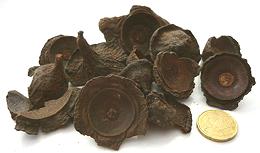 [Ocotea quixos]
[Ocotea quixos]
This tree, native to Ecuador and Colombia, is harvested for bark marketed
as Ecuadorian or American Cinnamon, which is similar to but not identical
to Asian cinnamon. Locally, the fruit cupules (hard shells around the
fruit) are harvested and have been used as a spice since the days of the
Incas. This spice is used for general cooking, but is particularly
important for food offerings to the ancestors. It is also used to flavor
an alcoholic drink called alajua.
Oils from this tree present a number of significant medicinal properties,
but more study is needed for general use. The photo shows dried fruit
cupules.
Photo by Cillas distributed under license
Creative Commons
Attribution 3.0 Unported.
Tola
 [Spicy Cedar; Beilschmiedia mannii]
[Spicy Cedar; Beilschmiedia mannii]
Native to West and Central Africa from Guinea Bissau to Democratic
Republic of the Congo, this small to medium tree bears small fruit that
turns red when ripe. It holds a single seed which is toasted and ground
for use as a condiment in soups, rice and vegetable dishes. The aromatic
leaves are crushed and soaked in water for a couple of days, then strained
to produce a refreshing beverage. The fruit is eaten raw or incorporated
into sauces. The bark is pounded and eaten as a condiment with rice.
In North America, the toasted and ground seeds are available on-line
from sellers of African food products for around 2018 US $1.75 / ounce.
Drawing by Achmad Satiri Nurhaman, copyright status
unknown, but seems to be expired.
Keule
 [Queule, Hualhual; Gomortega keule of family Gomortegaceae]
[Queule, Hualhual; Gomortega keule of family Gomortegaceae]
This tall tree, native to a small region of Chile, is the only species
in family Gomortegaceae and the only culinary member of order
Laurales outside the Laurel family, so we're putting it here.
This tree produces a soft, sweet yellow fruit about 1-3/4 inches in
diameter that is used to make a kind of marmalade. The tree is Red List
status EN (Endangered) due to over-harvesting and land clearing.
Photo by Diego Alarcón distributed under license
Creative Commons
Attribution 3.0 Unported.
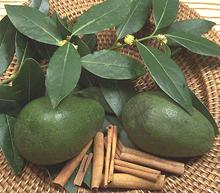



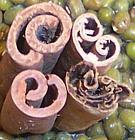 Cassia bark is much thicker and often a darker color than Cinnamon
which can be almost paper thin. Cassia tends to curl from one side
into a cylindrical quill while Cinnamon curls from two sides into two
cylinders taking a double scroll shape quill, though exceptions will be
found in both cases. Shown are two sticks of Cassia (left), a stick of
Cinnamon (top right) and a stick of Cinnamon made up of paper thin
layers.
Cassia bark is much thicker and often a darker color than Cinnamon
which can be almost paper thin. Cassia tends to curl from one side
into a cylindrical quill while Cinnamon curls from two sides into two
cylinders taking a double scroll shape quill, though exceptions will be
found in both cases. Shown are two sticks of Cassia (left), a stick of
Cinnamon (top right) and a stick of Cinnamon made up of paper thin
layers.